E-Commerce Security
VerifiedAdded on 2023/01/19
|19
|4445
|39
AI Summary
This research study focuses on the security aspects of e-commerce. It discusses the threats towards e-commerce, components of e-commerce security, and the biggest threats. It also provides examples of e-commerce services and implementation of client-side and server-side security. The aim is to measure the security of different websites based on e-commerce and discuss the privacy issues during transactions.
Contribute Materials
Your contribution can guide someone’s learning journey. Share your
documents today.

Running head: E-COMMERCE SECURITY
E-Commerce Security
Name of the Student
Name of the University
Author’s note
E-Commerce Security
Name of the Student
Name of the University
Author’s note
Secure Best Marks with AI Grader
Need help grading? Try our AI Grader for instant feedback on your assignments.
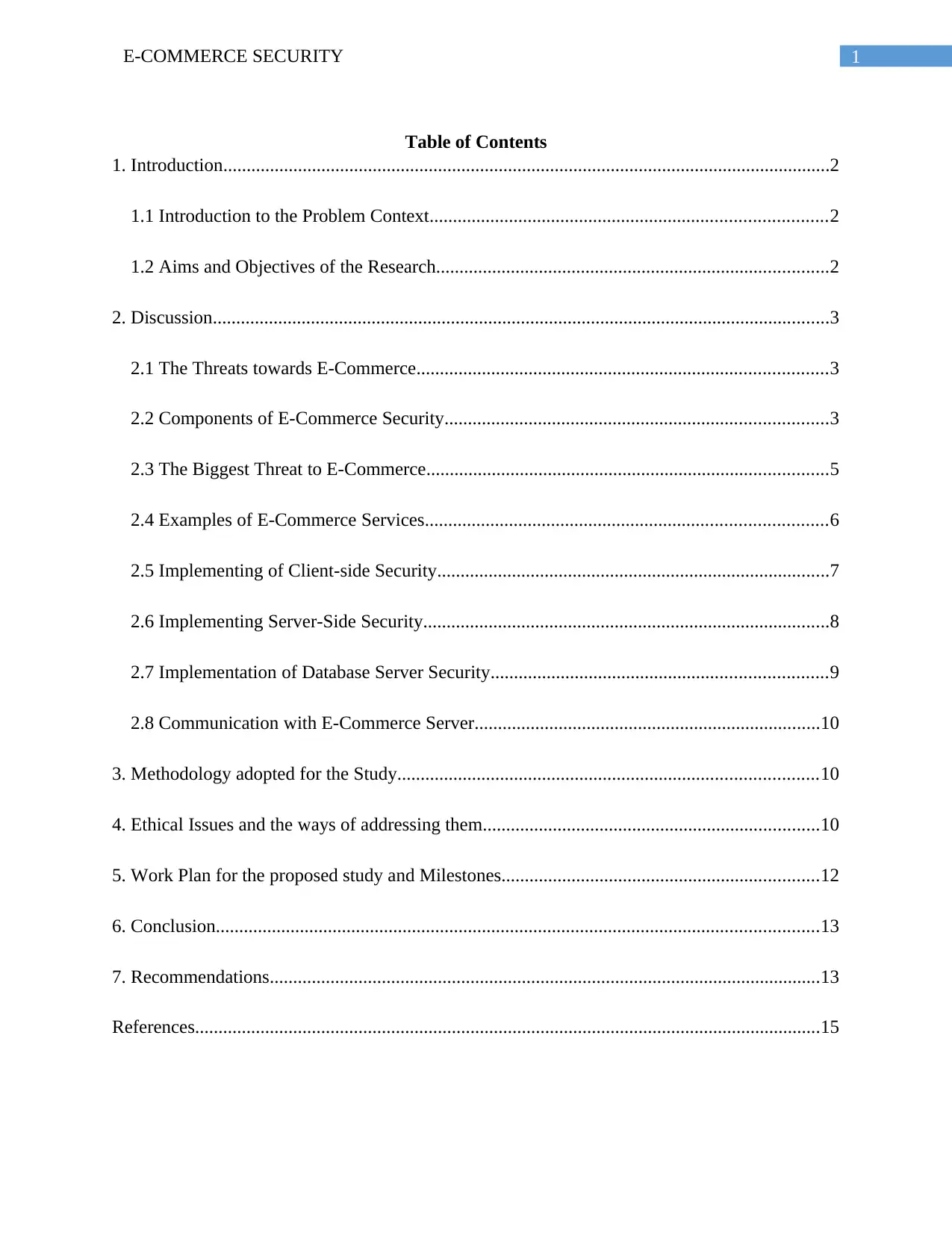
1E-COMMERCE SECURITY
Table of Contents
1. Introduction..................................................................................................................................2
1.1 Introduction to the Problem Context.....................................................................................2
1.2 Aims and Objectives of the Research....................................................................................2
2. Discussion....................................................................................................................................3
2.1 The Threats towards E-Commerce........................................................................................3
2.2 Components of E-Commerce Security..................................................................................3
2.3 The Biggest Threat to E-Commerce......................................................................................5
2.4 Examples of E-Commerce Services......................................................................................6
2.5 Implementing of Client-side Security....................................................................................7
2.6 Implementing Server-Side Security.......................................................................................8
2.7 Implementation of Database Server Security........................................................................9
2.8 Communication with E-Commerce Server..........................................................................10
3. Methodology adopted for the Study..........................................................................................10
4. Ethical Issues and the ways of addressing them........................................................................10
5. Work Plan for the proposed study and Milestones....................................................................12
6. Conclusion.................................................................................................................................13
7. Recommendations......................................................................................................................13
References......................................................................................................................................15
Table of Contents
1. Introduction..................................................................................................................................2
1.1 Introduction to the Problem Context.....................................................................................2
1.2 Aims and Objectives of the Research....................................................................................2
2. Discussion....................................................................................................................................3
2.1 The Threats towards E-Commerce........................................................................................3
2.2 Components of E-Commerce Security..................................................................................3
2.3 The Biggest Threat to E-Commerce......................................................................................5
2.4 Examples of E-Commerce Services......................................................................................6
2.5 Implementing of Client-side Security....................................................................................7
2.6 Implementing Server-Side Security.......................................................................................8
2.7 Implementation of Database Server Security........................................................................9
2.8 Communication with E-Commerce Server..........................................................................10
3. Methodology adopted for the Study..........................................................................................10
4. Ethical Issues and the ways of addressing them........................................................................10
5. Work Plan for the proposed study and Milestones....................................................................12
6. Conclusion.................................................................................................................................13
7. Recommendations......................................................................................................................13
References......................................................................................................................................15
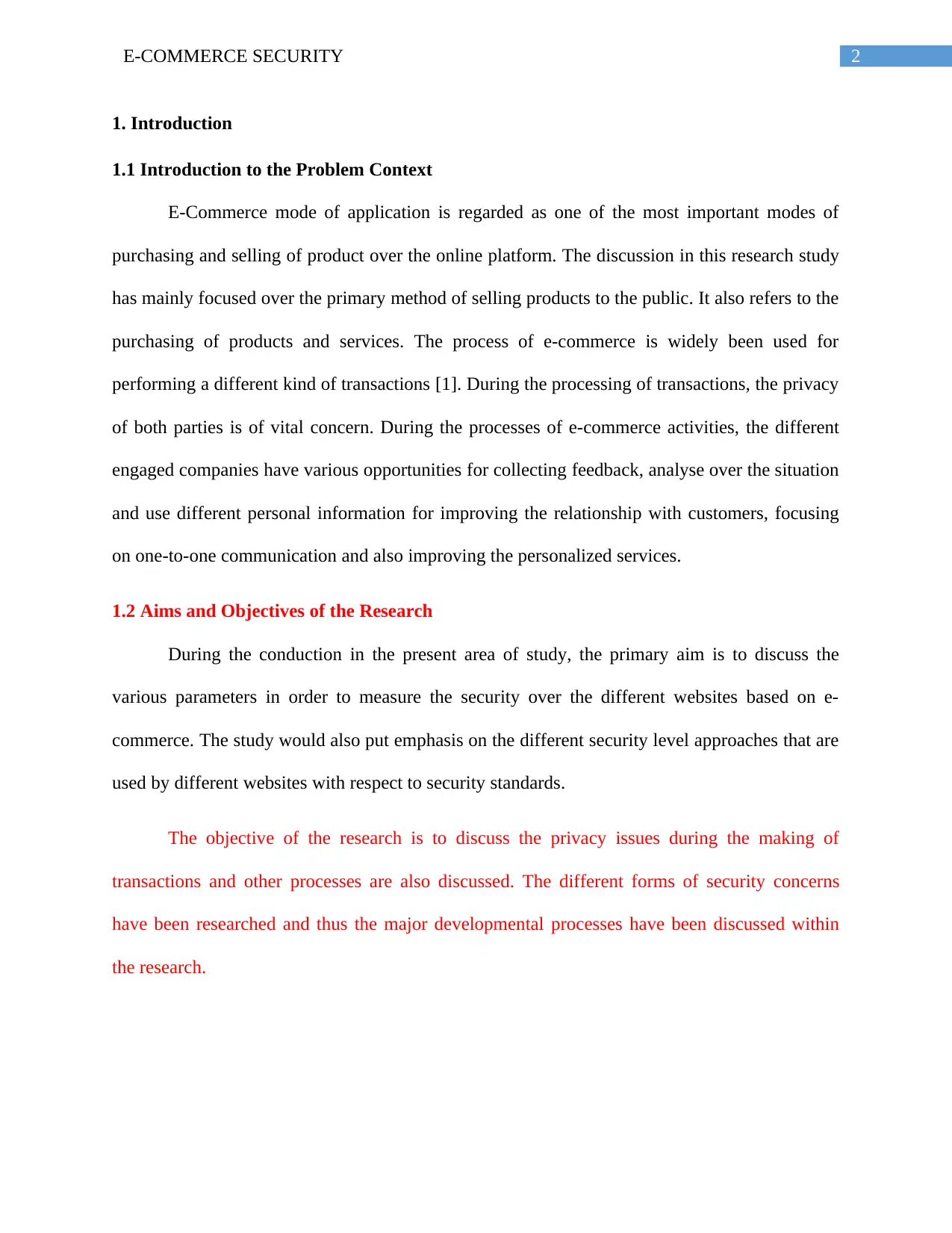
2E-COMMERCE SECURITY
1. Introduction
1.1 Introduction to the Problem Context
E-Commerce mode of application is regarded as one of the most important modes of
purchasing and selling of product over the online platform. The discussion in this research study
has mainly focused over the primary method of selling products to the public. It also refers to the
purchasing of products and services. The process of e-commerce is widely been used for
performing a different kind of transactions [1]. During the processing of transactions, the privacy
of both parties is of vital concern. During the processes of e-commerce activities, the different
engaged companies have various opportunities for collecting feedback, analyse over the situation
and use different personal information for improving the relationship with customers, focusing
on one-to-one communication and also improving the personalized services.
1.2 Aims and Objectives of the Research
During the conduction in the present area of study, the primary aim is to discuss the
various parameters in order to measure the security over the different websites based on e-
commerce. The study would also put emphasis on the different security level approaches that are
used by different websites with respect to security standards.
The objective of the research is to discuss the privacy issues during the making of
transactions and other processes are also discussed. The different forms of security concerns
have been researched and thus the major developmental processes have been discussed within
the research.
1. Introduction
1.1 Introduction to the Problem Context
E-Commerce mode of application is regarded as one of the most important modes of
purchasing and selling of product over the online platform. The discussion in this research study
has mainly focused over the primary method of selling products to the public. It also refers to the
purchasing of products and services. The process of e-commerce is widely been used for
performing a different kind of transactions [1]. During the processing of transactions, the privacy
of both parties is of vital concern. During the processes of e-commerce activities, the different
engaged companies have various opportunities for collecting feedback, analyse over the situation
and use different personal information for improving the relationship with customers, focusing
on one-to-one communication and also improving the personalized services.
1.2 Aims and Objectives of the Research
During the conduction in the present area of study, the primary aim is to discuss the
various parameters in order to measure the security over the different websites based on e-
commerce. The study would also put emphasis on the different security level approaches that are
used by different websites with respect to security standards.
The objective of the research is to discuss the privacy issues during the making of
transactions and other processes are also discussed. The different forms of security concerns
have been researched and thus the major developmental processes have been discussed within
the research.
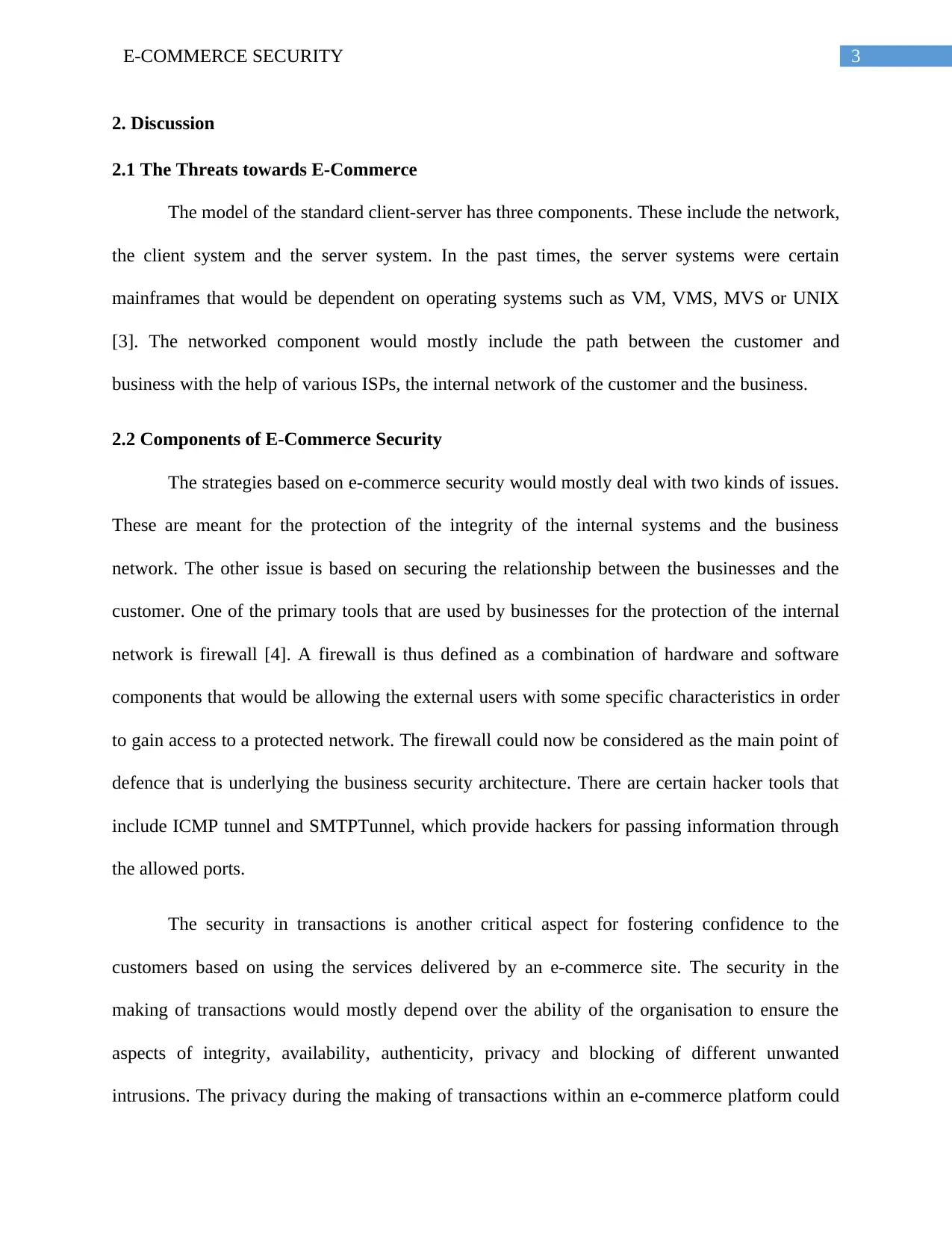
3E-COMMERCE SECURITY
2. Discussion
2.1 The Threats towards E-Commerce
The model of the standard client-server has three components. These include the network,
the client system and the server system. In the past times, the server systems were certain
mainframes that would be dependent on operating systems such as VM, VMS, MVS or UNIX
[3]. The networked component would mostly include the path between the customer and
business with the help of various ISPs, the internal network of the customer and the business.
2.2 Components of E-Commerce Security
The strategies based on e-commerce security would mostly deal with two kinds of issues.
These are meant for the protection of the integrity of the internal systems and the business
network. The other issue is based on securing the relationship between the businesses and the
customer. One of the primary tools that are used by businesses for the protection of the internal
network is firewall [4]. A firewall is thus defined as a combination of hardware and software
components that would be allowing the external users with some specific characteristics in order
to gain access to a protected network. The firewall could now be considered as the main point of
defence that is underlying the business security architecture. There are certain hacker tools that
include ICMP tunnel and SMTPTunnel, which provide hackers for passing information through
the allowed ports.
The security in transactions is another critical aspect for fostering confidence to the
customers based on using the services delivered by an e-commerce site. The security in the
making of transactions would mostly depend over the ability of the organisation to ensure the
aspects of integrity, availability, authenticity, privacy and blocking of different unwanted
intrusions. The privacy during the making of transactions within an e-commerce platform could
2. Discussion
2.1 The Threats towards E-Commerce
The model of the standard client-server has three components. These include the network,
the client system and the server system. In the past times, the server systems were certain
mainframes that would be dependent on operating systems such as VM, VMS, MVS or UNIX
[3]. The networked component would mostly include the path between the customer and
business with the help of various ISPs, the internal network of the customer and the business.
2.2 Components of E-Commerce Security
The strategies based on e-commerce security would mostly deal with two kinds of issues.
These are meant for the protection of the integrity of the internal systems and the business
network. The other issue is based on securing the relationship between the businesses and the
customer. One of the primary tools that are used by businesses for the protection of the internal
network is firewall [4]. A firewall is thus defined as a combination of hardware and software
components that would be allowing the external users with some specific characteristics in order
to gain access to a protected network. The firewall could now be considered as the main point of
defence that is underlying the business security architecture. There are certain hacker tools that
include ICMP tunnel and SMTPTunnel, which provide hackers for passing information through
the allowed ports.
The security in transactions is another critical aspect for fostering confidence to the
customers based on using the services delivered by an e-commerce site. The security in the
making of transactions would mostly depend over the ability of the organisation to ensure the
aspects of integrity, availability, authenticity, privacy and blocking of different unwanted
intrusions. The privacy during the making of transactions within an e-commerce platform could
Secure Best Marks with AI Grader
Need help grading? Try our AI Grader for instant feedback on your assignments.
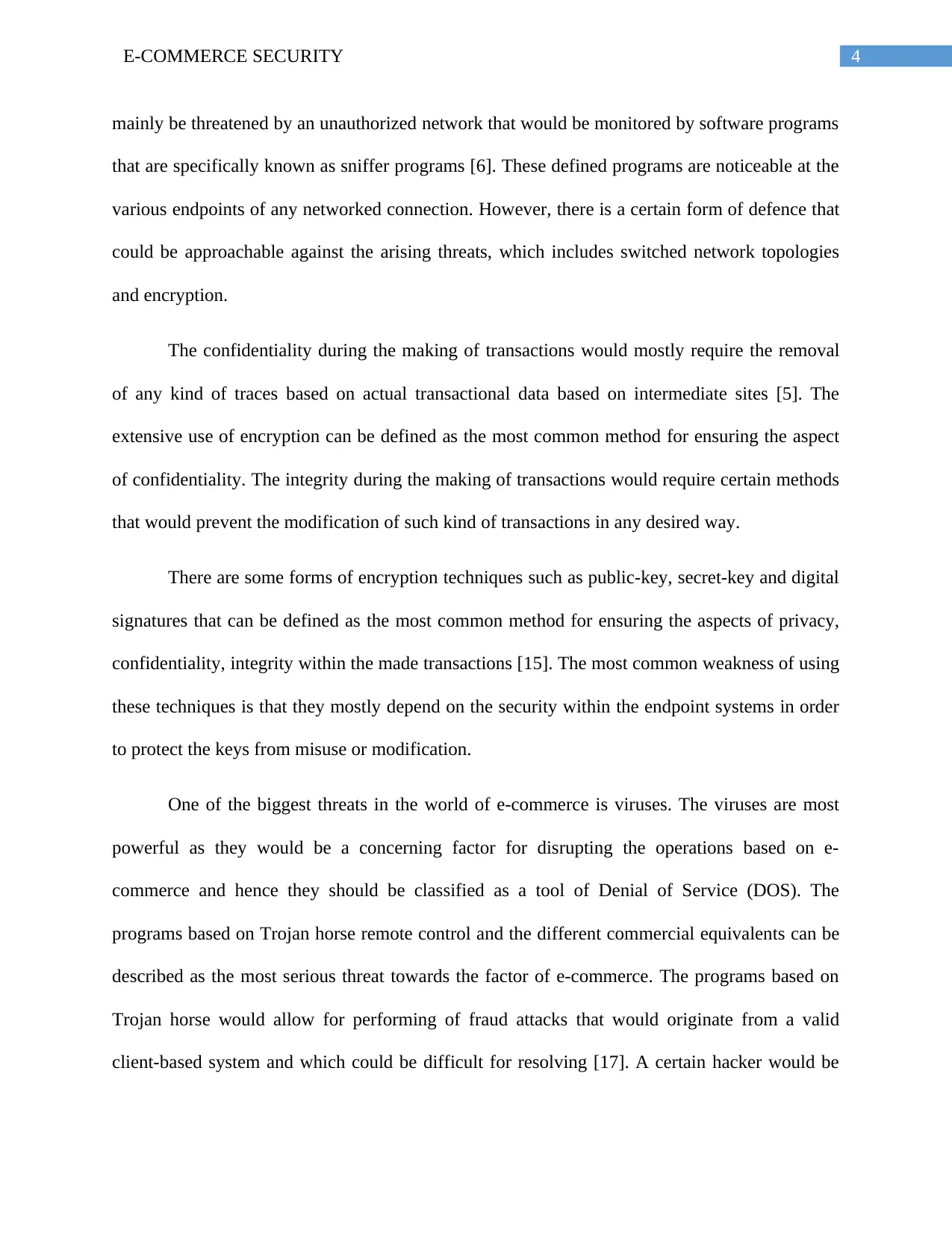
4E-COMMERCE SECURITY
mainly be threatened by an unauthorized network that would be monitored by software programs
that are specifically known as sniffer programs [6]. These defined programs are noticeable at the
various endpoints of any networked connection. However, there is a certain form of defence that
could be approachable against the arising threats, which includes switched network topologies
and encryption.
The confidentiality during the making of transactions would mostly require the removal
of any kind of traces based on actual transactional data based on intermediate sites [5]. The
extensive use of encryption can be defined as the most common method for ensuring the aspect
of confidentiality. The integrity during the making of transactions would require certain methods
that would prevent the modification of such kind of transactions in any desired way.
There are some forms of encryption techniques such as public-key, secret-key and digital
signatures that can be defined as the most common method for ensuring the aspects of privacy,
confidentiality, integrity within the made transactions [15]. The most common weakness of using
these techniques is that they mostly depend on the security within the endpoint systems in order
to protect the keys from misuse or modification.
One of the biggest threats in the world of e-commerce is viruses. The viruses are most
powerful as they would be a concerning factor for disrupting the operations based on e-
commerce and hence they should be classified as a tool of Denial of Service (DOS). The
programs based on Trojan horse remote control and the different commercial equivalents can be
described as the most serious threat towards the factor of e-commerce. The programs based on
Trojan horse would allow for performing of fraud attacks that would originate from a valid
client-based system and which could be difficult for resolving [17]. A certain hacker would be
mainly be threatened by an unauthorized network that would be monitored by software programs
that are specifically known as sniffer programs [6]. These defined programs are noticeable at the
various endpoints of any networked connection. However, there is a certain form of defence that
could be approachable against the arising threats, which includes switched network topologies
and encryption.
The confidentiality during the making of transactions would mostly require the removal
of any kind of traces based on actual transactional data based on intermediate sites [5]. The
extensive use of encryption can be defined as the most common method for ensuring the aspect
of confidentiality. The integrity during the making of transactions would require certain methods
that would prevent the modification of such kind of transactions in any desired way.
There are some forms of encryption techniques such as public-key, secret-key and digital
signatures that can be defined as the most common method for ensuring the aspects of privacy,
confidentiality, integrity within the made transactions [15]. The most common weakness of using
these techniques is that they mostly depend on the security within the endpoint systems in order
to protect the keys from misuse or modification.
One of the biggest threats in the world of e-commerce is viruses. The viruses are most
powerful as they would be a concerning factor for disrupting the operations based on e-
commerce and hence they should be classified as a tool of Denial of Service (DOS). The
programs based on Trojan horse remote control and the different commercial equivalents can be
described as the most serious threat towards the factor of e-commerce. The programs based on
Trojan horse would allow for performing of fraud attacks that would originate from a valid
client-based system and which could be difficult for resolving [17]. A certain hacker would be
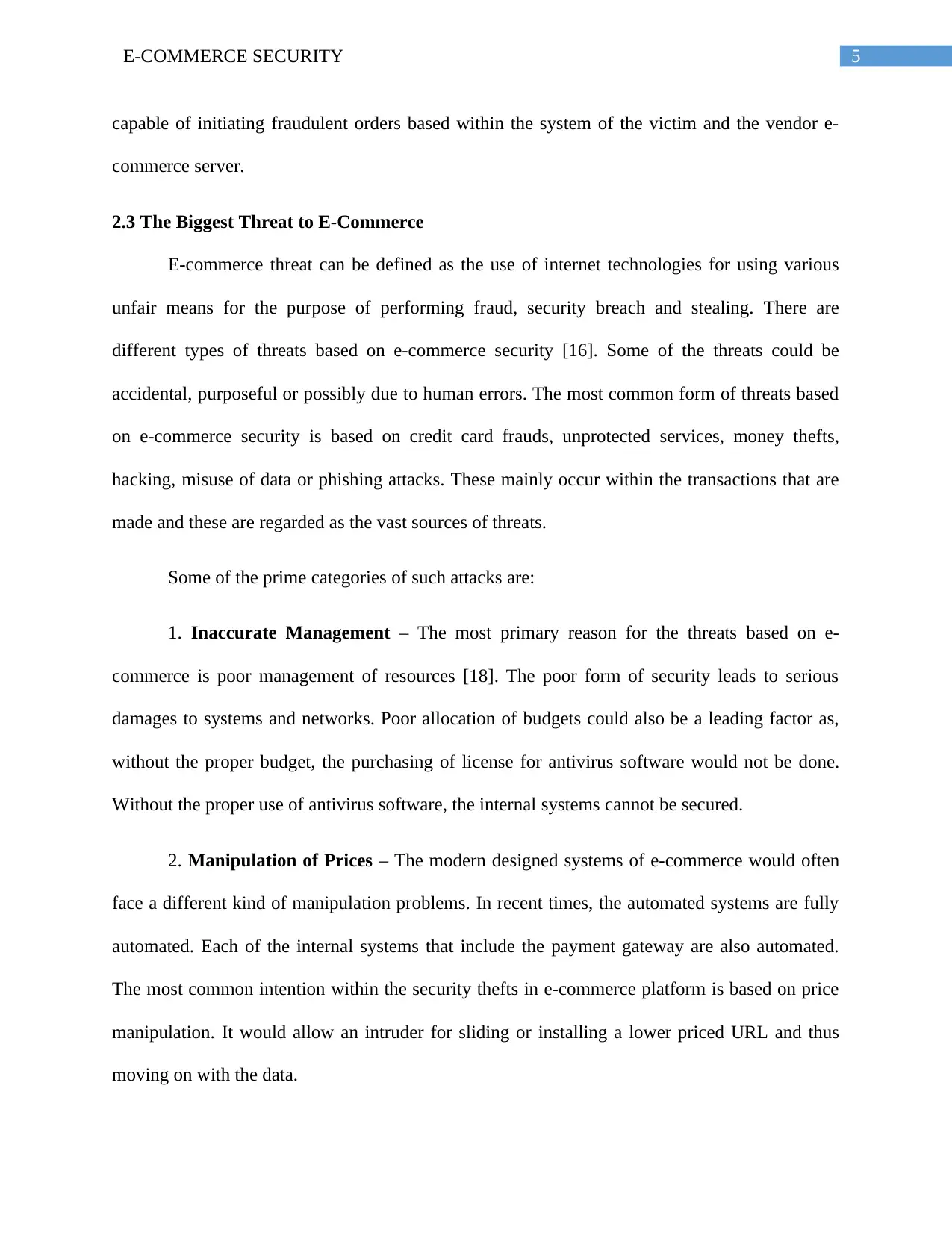
5E-COMMERCE SECURITY
capable of initiating fraudulent orders based within the system of the victim and the vendor e-
commerce server.
2.3 The Biggest Threat to E-Commerce
E-commerce threat can be defined as the use of internet technologies for using various
unfair means for the purpose of performing fraud, security breach and stealing. There are
different types of threats based on e-commerce security [16]. Some of the threats could be
accidental, purposeful or possibly due to human errors. The most common form of threats based
on e-commerce security is based on credit card frauds, unprotected services, money thefts,
hacking, misuse of data or phishing attacks. These mainly occur within the transactions that are
made and these are regarded as the vast sources of threats.
Some of the prime categories of such attacks are:
1. Inaccurate Management – The most primary reason for the threats based on e-
commerce is poor management of resources [18]. The poor form of security leads to serious
damages to systems and networks. Poor allocation of budgets could also be a leading factor as,
without the proper budget, the purchasing of license for antivirus software would not be done.
Without the proper use of antivirus software, the internal systems cannot be secured.
2. Manipulation of Prices – The modern designed systems of e-commerce would often
face a different kind of manipulation problems. In recent times, the automated systems are fully
automated. Each of the internal systems that include the payment gateway are also automated.
The most common intention within the security thefts in e-commerce platform is based on price
manipulation. It would allow an intruder for sliding or installing a lower priced URL and thus
moving on with the data.
capable of initiating fraudulent orders based within the system of the victim and the vendor e-
commerce server.
2.3 The Biggest Threat to E-Commerce
E-commerce threat can be defined as the use of internet technologies for using various
unfair means for the purpose of performing fraud, security breach and stealing. There are
different types of threats based on e-commerce security [16]. Some of the threats could be
accidental, purposeful or possibly due to human errors. The most common form of threats based
on e-commerce security is based on credit card frauds, unprotected services, money thefts,
hacking, misuse of data or phishing attacks. These mainly occur within the transactions that are
made and these are regarded as the vast sources of threats.
Some of the prime categories of such attacks are:
1. Inaccurate Management – The most primary reason for the threats based on e-
commerce is poor management of resources [18]. The poor form of security leads to serious
damages to systems and networks. Poor allocation of budgets could also be a leading factor as,
without the proper budget, the purchasing of license for antivirus software would not be done.
Without the proper use of antivirus software, the internal systems cannot be secured.
2. Manipulation of Prices – The modern designed systems of e-commerce would often
face a different kind of manipulation problems. In recent times, the automated systems are fully
automated. Each of the internal systems that include the payment gateway are also automated.
The most common intention within the security thefts in e-commerce platform is based on price
manipulation. It would allow an intruder for sliding or installing a lower priced URL and thus
moving on with the data.
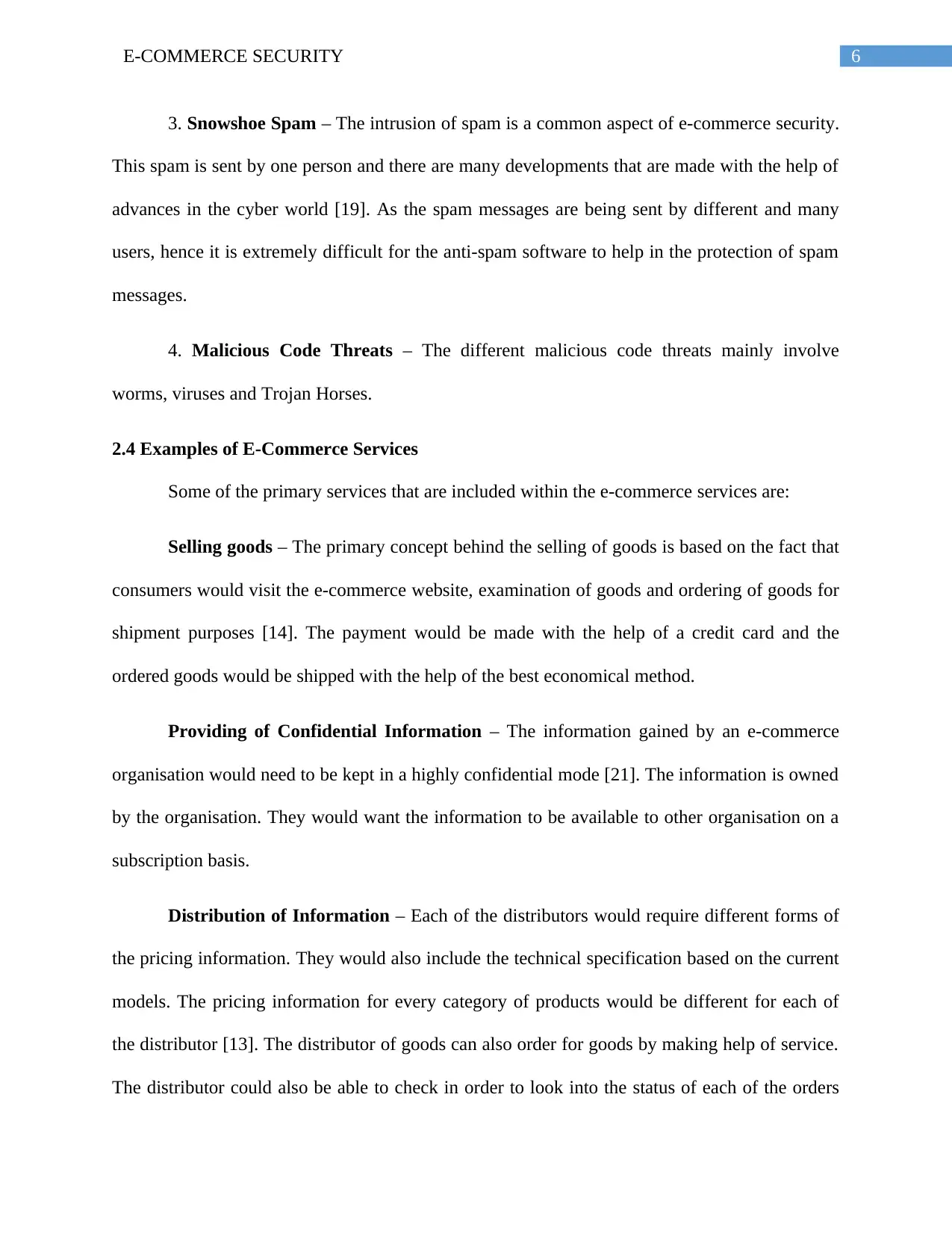
6E-COMMERCE SECURITY
3. Snowshoe Spam – The intrusion of spam is a common aspect of e-commerce security.
This spam is sent by one person and there are many developments that are made with the help of
advances in the cyber world [19]. As the spam messages are being sent by different and many
users, hence it is extremely difficult for the anti-spam software to help in the protection of spam
messages.
4. Malicious Code Threats – The different malicious code threats mainly involve
worms, viruses and Trojan Horses.
2.4 Examples of E-Commerce Services
Some of the primary services that are included within the e-commerce services are:
Selling goods – The primary concept behind the selling of goods is based on the fact that
consumers would visit the e-commerce website, examination of goods and ordering of goods for
shipment purposes [14]. The payment would be made with the help of a credit card and the
ordered goods would be shipped with the help of the best economical method.
Providing of Confidential Information – The information gained by an e-commerce
organisation would need to be kept in a highly confidential mode [21]. The information is owned
by the organisation. They would want the information to be available to other organisation on a
subscription basis.
Distribution of Information – Each of the distributors would require different forms of
the pricing information. They would also include the technical specification based on the current
models. The pricing information for every category of products would be different for each of
the distributor [13]. The distributor of goods can also order for goods by making help of service.
The distributor could also be able to check in order to look into the status of each of the orders
3. Snowshoe Spam – The intrusion of spam is a common aspect of e-commerce security.
This spam is sent by one person and there are many developments that are made with the help of
advances in the cyber world [19]. As the spam messages are being sent by different and many
users, hence it is extremely difficult for the anti-spam software to help in the protection of spam
messages.
4. Malicious Code Threats – The different malicious code threats mainly involve
worms, viruses and Trojan Horses.
2.4 Examples of E-Commerce Services
Some of the primary services that are included within the e-commerce services are:
Selling goods – The primary concept behind the selling of goods is based on the fact that
consumers would visit the e-commerce website, examination of goods and ordering of goods for
shipment purposes [14]. The payment would be made with the help of a credit card and the
ordered goods would be shipped with the help of the best economical method.
Providing of Confidential Information – The information gained by an e-commerce
organisation would need to be kept in a highly confidential mode [21]. The information is owned
by the organisation. They would want the information to be available to other organisation on a
subscription basis.
Distribution of Information – Each of the distributors would require different forms of
the pricing information. They would also include the technical specification based on the current
models. The pricing information for every category of products would be different for each of
the distributor [13]. The distributor of goods can also order for goods by making help of service.
The distributor could also be able to check in order to look into the status of each of the orders
Paraphrase This Document
Need a fresh take? Get an instant paraphrase of this document with our AI Paraphraser
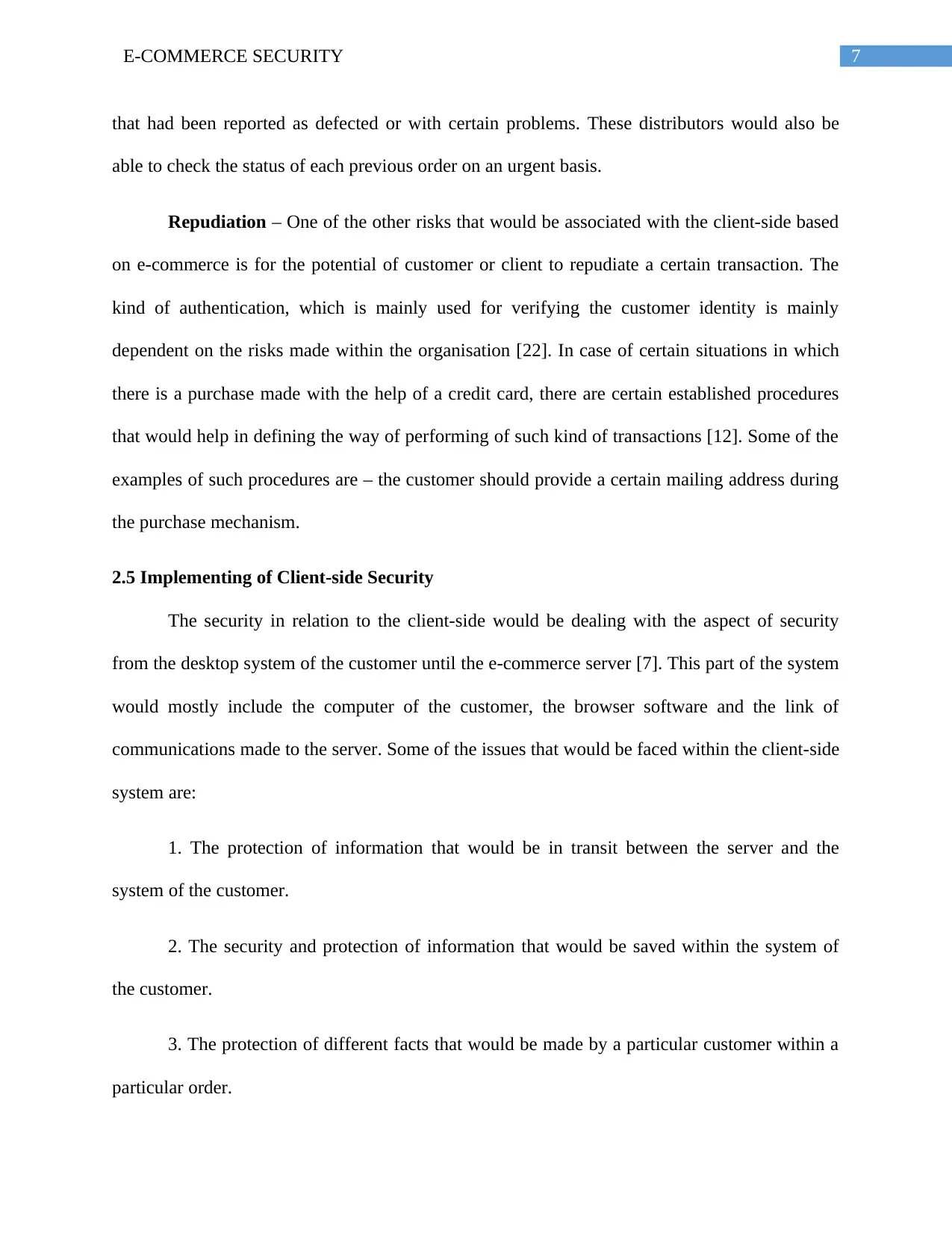
7E-COMMERCE SECURITY
that had been reported as defected or with certain problems. These distributors would also be
able to check the status of each previous order on an urgent basis.
Repudiation – One of the other risks that would be associated with the client-side based
on e-commerce is for the potential of customer or client to repudiate a certain transaction. The
kind of authentication, which is mainly used for verifying the customer identity is mainly
dependent on the risks made within the organisation [22]. In case of certain situations in which
there is a purchase made with the help of a credit card, there are certain established procedures
that would help in defining the way of performing of such kind of transactions [12]. Some of the
examples of such procedures are – the customer should provide a certain mailing address during
the purchase mechanism.
2.5 Implementing of Client-side Security
The security in relation to the client-side would be dealing with the aspect of security
from the desktop system of the customer until the e-commerce server [7]. This part of the system
would mostly include the computer of the customer, the browser software and the link of
communications made to the server. Some of the issues that would be faced within the client-side
system are:
1. The protection of information that would be in transit between the server and the
system of the customer.
2. The security and protection of information that would be saved within the system of
the customer.
3. The protection of different facts that would be made by a particular customer within a
particular order.
that had been reported as defected or with certain problems. These distributors would also be
able to check the status of each previous order on an urgent basis.
Repudiation – One of the other risks that would be associated with the client-side based
on e-commerce is for the potential of customer or client to repudiate a certain transaction. The
kind of authentication, which is mainly used for verifying the customer identity is mainly
dependent on the risks made within the organisation [22]. In case of certain situations in which
there is a purchase made with the help of a credit card, there are certain established procedures
that would help in defining the way of performing of such kind of transactions [12]. Some of the
examples of such procedures are – the customer should provide a certain mailing address during
the purchase mechanism.
2.5 Implementing of Client-side Security
The security in relation to the client-side would be dealing with the aspect of security
from the desktop system of the customer until the e-commerce server [7]. This part of the system
would mostly include the computer of the customer, the browser software and the link of
communications made to the server. Some of the issues that would be faced within the client-side
system are:
1. The protection of information that would be in transit between the server and the
system of the customer.
2. The security and protection of information that would be saved within the system of
the customer.
3. The protection of different facts that would be made by a particular customer within a
particular order.
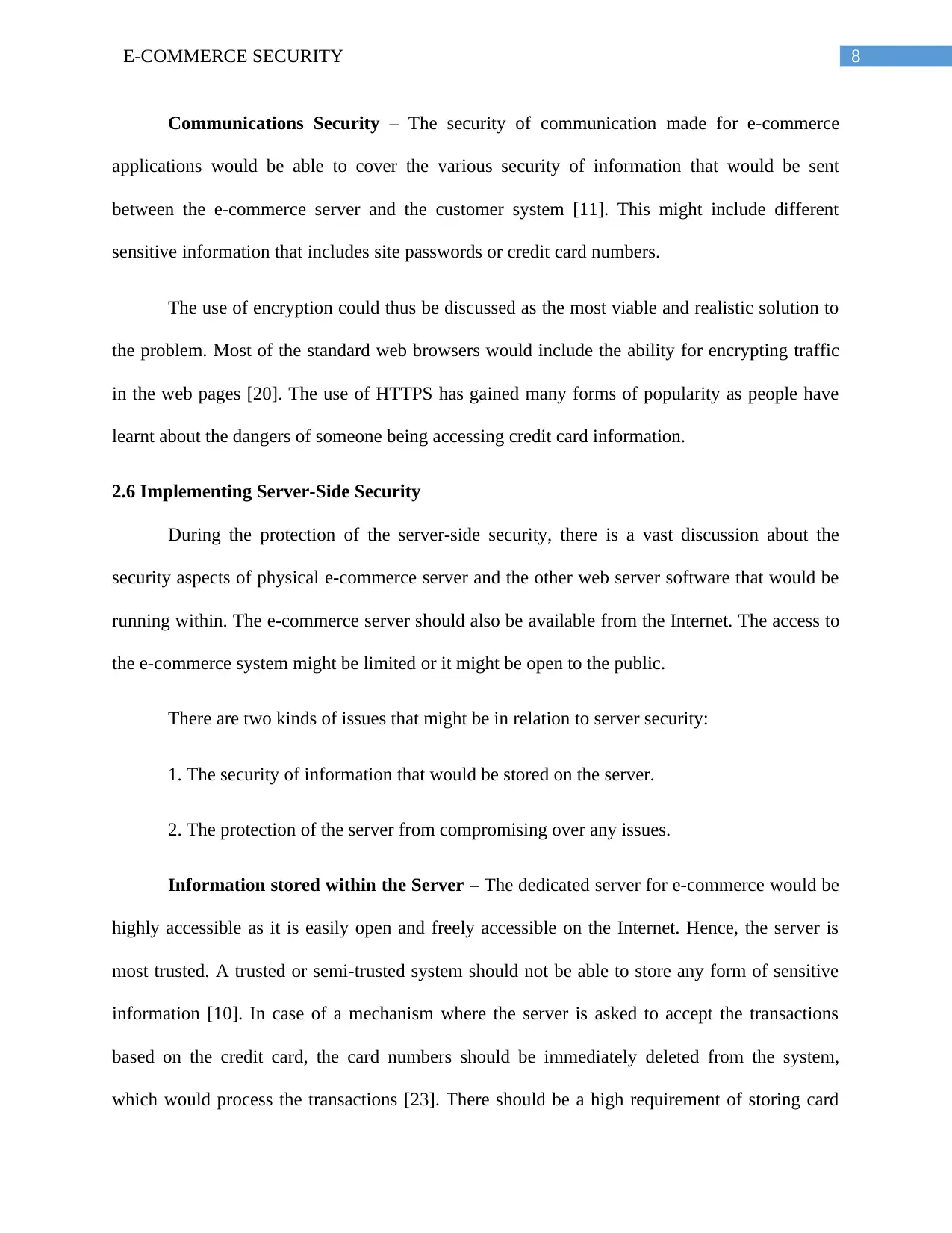
8E-COMMERCE SECURITY
Communications Security – The security of communication made for e-commerce
applications would be able to cover the various security of information that would be sent
between the e-commerce server and the customer system [11]. This might include different
sensitive information that includes site passwords or credit card numbers.
The use of encryption could thus be discussed as the most viable and realistic solution to
the problem. Most of the standard web browsers would include the ability for encrypting traffic
in the web pages [20]. The use of HTTPS has gained many forms of popularity as people have
learnt about the dangers of someone being accessing credit card information.
2.6 Implementing Server-Side Security
During the protection of the server-side security, there is a vast discussion about the
security aspects of physical e-commerce server and the other web server software that would be
running within. The e-commerce server should also be available from the Internet. The access to
the e-commerce system might be limited or it might be open to the public.
There are two kinds of issues that might be in relation to server security:
1. The security of information that would be stored on the server.
2. The protection of the server from compromising over any issues.
Information stored within the Server – The dedicated server for e-commerce would be
highly accessible as it is easily open and freely accessible on the Internet. Hence, the server is
most trusted. A trusted or semi-trusted system should not be able to store any form of sensitive
information [10]. In case of a mechanism where the server is asked to accept the transactions
based on the credit card, the card numbers should be immediately deleted from the system,
which would process the transactions [23]. There should be a high requirement of storing card
Communications Security – The security of communication made for e-commerce
applications would be able to cover the various security of information that would be sent
between the e-commerce server and the customer system [11]. This might include different
sensitive information that includes site passwords or credit card numbers.
The use of encryption could thus be discussed as the most viable and realistic solution to
the problem. Most of the standard web browsers would include the ability for encrypting traffic
in the web pages [20]. The use of HTTPS has gained many forms of popularity as people have
learnt about the dangers of someone being accessing credit card information.
2.6 Implementing Server-Side Security
During the protection of the server-side security, there is a vast discussion about the
security aspects of physical e-commerce server and the other web server software that would be
running within. The e-commerce server should also be available from the Internet. The access to
the e-commerce system might be limited or it might be open to the public.
There are two kinds of issues that might be in relation to server security:
1. The security of information that would be stored on the server.
2. The protection of the server from compromising over any issues.
Information stored within the Server – The dedicated server for e-commerce would be
highly accessible as it is easily open and freely accessible on the Internet. Hence, the server is
most trusted. A trusted or semi-trusted system should not be able to store any form of sensitive
information [10]. In case of a mechanism where the server is asked to accept the transactions
based on the credit card, the card numbers should be immediately deleted from the system,
which would process the transactions [23]. There should be a high requirement of storing card
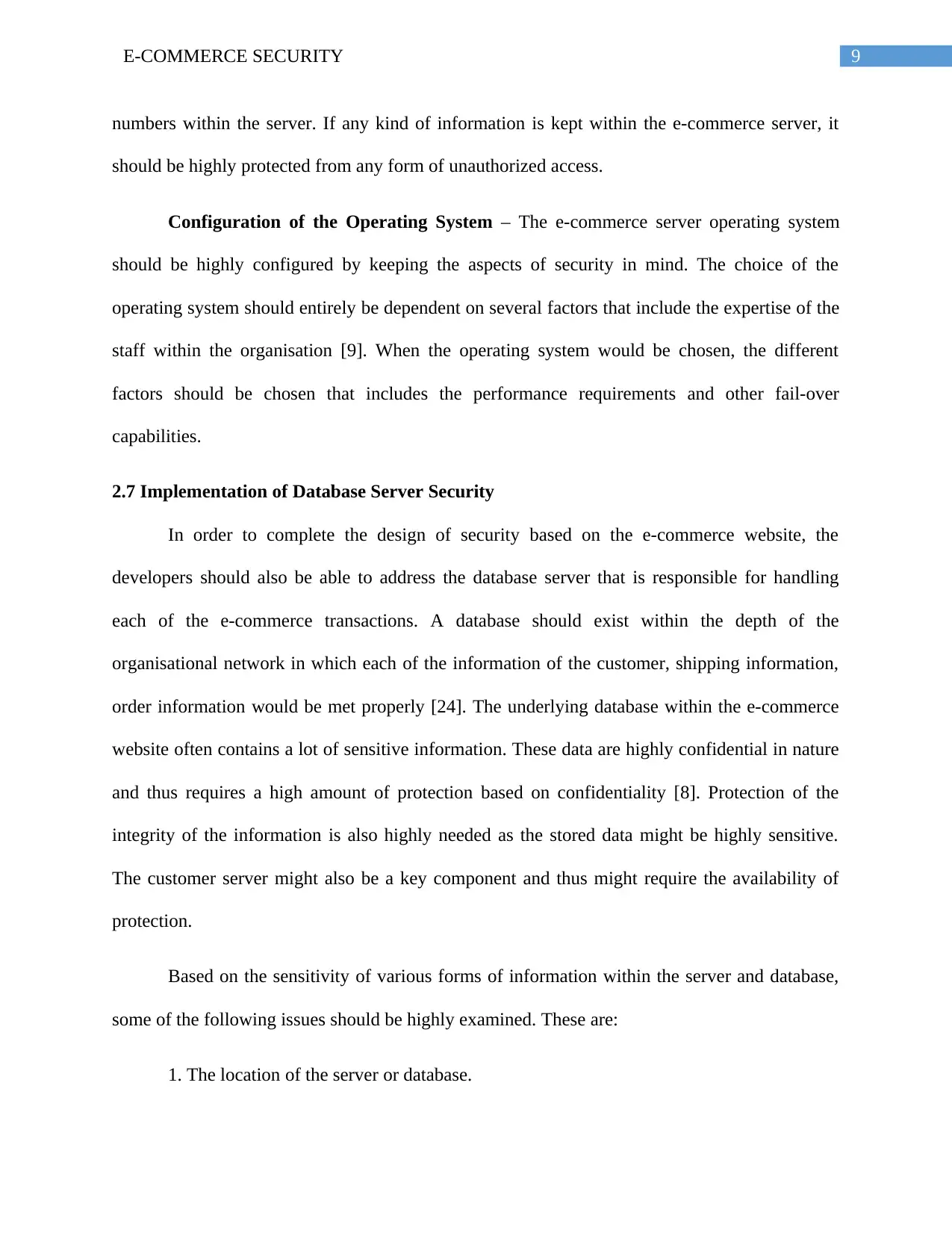
9E-COMMERCE SECURITY
numbers within the server. If any kind of information is kept within the e-commerce server, it
should be highly protected from any form of unauthorized access.
Configuration of the Operating System – The e-commerce server operating system
should be highly configured by keeping the aspects of security in mind. The choice of the
operating system should entirely be dependent on several factors that include the expertise of the
staff within the organisation [9]. When the operating system would be chosen, the different
factors should be chosen that includes the performance requirements and other fail-over
capabilities.
2.7 Implementation of Database Server Security
In order to complete the design of security based on the e-commerce website, the
developers should also be able to address the database server that is responsible for handling
each of the e-commerce transactions. A database should exist within the depth of the
organisational network in which each of the information of the customer, shipping information,
order information would be met properly [24]. The underlying database within the e-commerce
website often contains a lot of sensitive information. These data are highly confidential in nature
and thus requires a high amount of protection based on confidentiality [8]. Protection of the
integrity of the information is also highly needed as the stored data might be highly sensitive.
The customer server might also be a key component and thus might require the availability of
protection.
Based on the sensitivity of various forms of information within the server and database,
some of the following issues should be highly examined. These are:
1. The location of the server or database.
numbers within the server. If any kind of information is kept within the e-commerce server, it
should be highly protected from any form of unauthorized access.
Configuration of the Operating System – The e-commerce server operating system
should be highly configured by keeping the aspects of security in mind. The choice of the
operating system should entirely be dependent on several factors that include the expertise of the
staff within the organisation [9]. When the operating system would be chosen, the different
factors should be chosen that includes the performance requirements and other fail-over
capabilities.
2.7 Implementation of Database Server Security
In order to complete the design of security based on the e-commerce website, the
developers should also be able to address the database server that is responsible for handling
each of the e-commerce transactions. A database should exist within the depth of the
organisational network in which each of the information of the customer, shipping information,
order information would be met properly [24]. The underlying database within the e-commerce
website often contains a lot of sensitive information. These data are highly confidential in nature
and thus requires a high amount of protection based on confidentiality [8]. Protection of the
integrity of the information is also highly needed as the stored data might be highly sensitive.
The customer server might also be a key component and thus might require the availability of
protection.
Based on the sensitivity of various forms of information within the server and database,
some of the following issues should be highly examined. These are:
1. The location of the server or database.
Secure Best Marks with AI Grader
Need help grading? Try our AI Grader for instant feedback on your assignments.
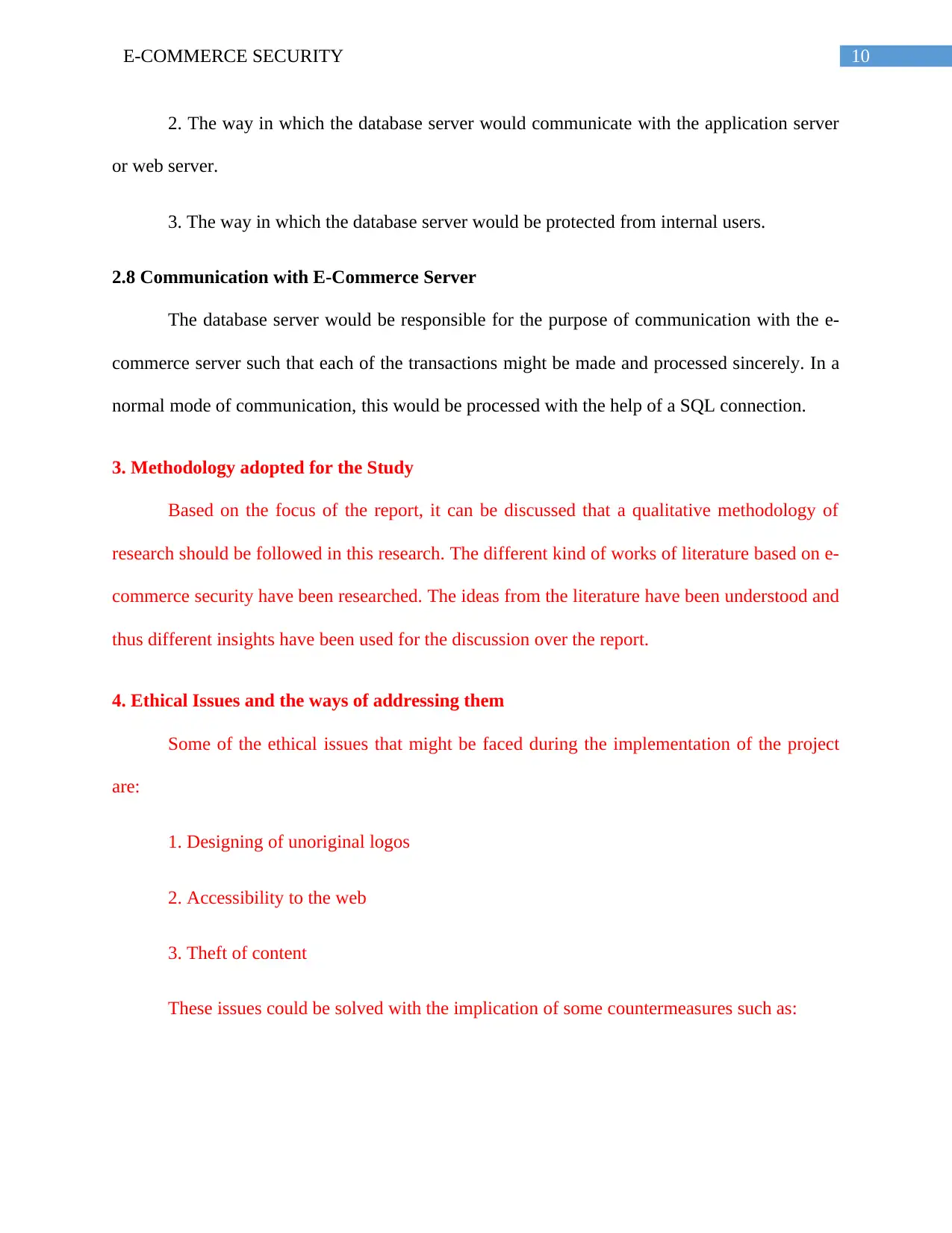
10E-COMMERCE SECURITY
2. The way in which the database server would communicate with the application server
or web server.
3. The way in which the database server would be protected from internal users.
2.8 Communication with E-Commerce Server
The database server would be responsible for the purpose of communication with the e-
commerce server such that each of the transactions might be made and processed sincerely. In a
normal mode of communication, this would be processed with the help of a SQL connection.
3. Methodology adopted for the Study
Based on the focus of the report, it can be discussed that a qualitative methodology of
research should be followed in this research. The different kind of works of literature based on e-
commerce security have been researched. The ideas from the literature have been understood and
thus different insights have been used for the discussion over the report.
4. Ethical Issues and the ways of addressing them
Some of the ethical issues that might be faced during the implementation of the project
are:
1. Designing of unoriginal logos
2. Accessibility to the web
3. Theft of content
These issues could be solved with the implication of some countermeasures such as:
2. The way in which the database server would communicate with the application server
or web server.
3. The way in which the database server would be protected from internal users.
2.8 Communication with E-Commerce Server
The database server would be responsible for the purpose of communication with the e-
commerce server such that each of the transactions might be made and processed sincerely. In a
normal mode of communication, this would be processed with the help of a SQL connection.
3. Methodology adopted for the Study
Based on the focus of the report, it can be discussed that a qualitative methodology of
research should be followed in this research. The different kind of works of literature based on e-
commerce security have been researched. The ideas from the literature have been understood and
thus different insights have been used for the discussion over the report.
4. Ethical Issues and the ways of addressing them
Some of the ethical issues that might be faced during the implementation of the project
are:
1. Designing of unoriginal logos
2. Accessibility to the web
3. Theft of content
These issues could be solved with the implication of some countermeasures such as:

11E-COMMERCE SECURITY
1. A logo designer should be hired who would be innovative in designing ideas based on
designing of logos [2]. The copies of the final design should be produced to the top level
management and thus copyright is made over the logo.
2. The company implementing the security should look into the web accessibility feature
that could also be useful for visually impaired people and thus help them in accessing each of the
contents in an easy manner.
3. Theft of content should not be done. The e-commerce business should discuss
strategies about implementing the best products within the business. Innovative listing of product
stock should be listed in order to prevent the violation of copyrights.
1. A logo designer should be hired who would be innovative in designing ideas based on
designing of logos [2]. The copies of the final design should be produced to the top level
management and thus copyright is made over the logo.
2. The company implementing the security should look into the web accessibility feature
that could also be useful for visually impaired people and thus help them in accessing each of the
contents in an easy manner.
3. Theft of content should not be done. The e-commerce business should discuss
strategies about implementing the best products within the business. Innovative listing of product
stock should be listed in order to prevent the violation of copyrights.
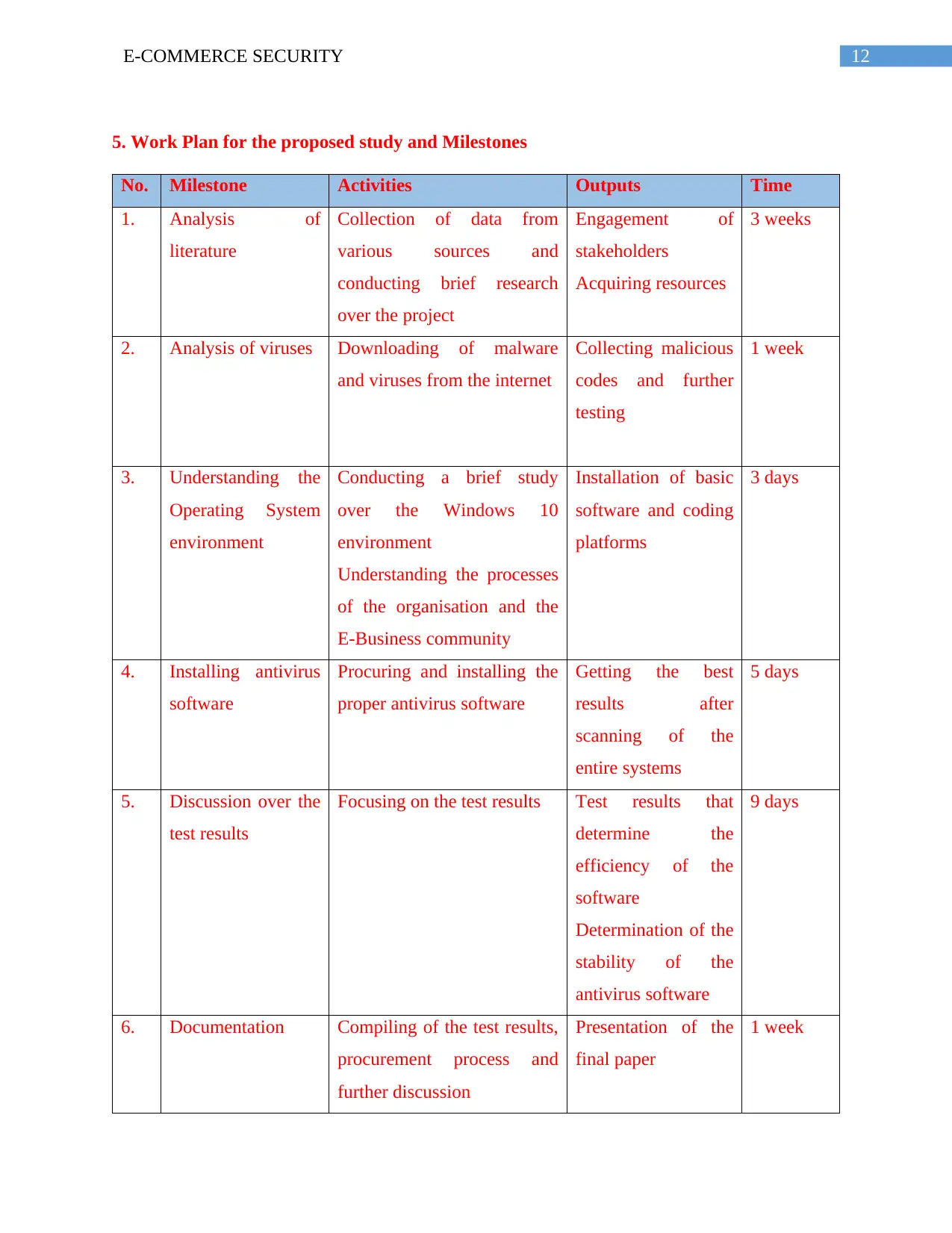
12E-COMMERCE SECURITY
5. Work Plan for the proposed study and Milestones
No. Milestone Activities Outputs Time
1. Analysis of
literature
Collection of data from
various sources and
conducting brief research
over the project
Engagement of
stakeholders
Acquiring resources
3 weeks
2. Analysis of viruses Downloading of malware
and viruses from the internet
Collecting malicious
codes and further
testing
1 week
3. Understanding the
Operating System
environment
Conducting a brief study
over the Windows 10
environment
Understanding the processes
of the organisation and the
E-Business community
Installation of basic
software and coding
platforms
3 days
4. Installing antivirus
software
Procuring and installing the
proper antivirus software
Getting the best
results after
scanning of the
entire systems
5 days
5. Discussion over the
test results
Focusing on the test results Test results that
determine the
efficiency of the
software
Determination of the
stability of the
antivirus software
9 days
6. Documentation Compiling of the test results,
procurement process and
further discussion
Presentation of the
final paper
1 week
5. Work Plan for the proposed study and Milestones
No. Milestone Activities Outputs Time
1. Analysis of
literature
Collection of data from
various sources and
conducting brief research
over the project
Engagement of
stakeholders
Acquiring resources
3 weeks
2. Analysis of viruses Downloading of malware
and viruses from the internet
Collecting malicious
codes and further
testing
1 week
3. Understanding the
Operating System
environment
Conducting a brief study
over the Windows 10
environment
Understanding the processes
of the organisation and the
E-Business community
Installation of basic
software and coding
platforms
3 days
4. Installing antivirus
software
Procuring and installing the
proper antivirus software
Getting the best
results after
scanning of the
entire systems
5 days
5. Discussion over the
test results
Focusing on the test results Test results that
determine the
efficiency of the
software
Determination of the
stability of the
antivirus software
9 days
6. Documentation Compiling of the test results,
procurement process and
further discussion
Presentation of the
final paper
1 week
Paraphrase This Document
Need a fresh take? Get an instant paraphrase of this document with our AI Paraphraser

13E-COMMERCE SECURITY

14E-COMMERCE SECURITY
6. Conclusion
Based on focusing over the various aspects of security that have approached over the e-
commerce industry, they have been in the process of addressing each of the issues in relation to
the security. The various guidelines that have been implemented within the e-commerce security
aspects should be implemented properly. Education to the customer in terms of the protection of
their assets is also an important necessity. From the discussion provided in the study, it has been
discussed that Trojan horse programs that had been launched against various client systems
would be the main cause for the attacks that have been implemented within the systems.
Different kind of authorization mechanisms should be used within an e-commerce transaction.
The developers should be responsible for securing the end-systems in order to ensure the security
of the various transactions. This would help in securing the various transactions and the related
processes that are made within the entire system. There are a lot of transactions and other
business processes that mainly happen within the e-commerce systems. Hence, these websites
should define better security standards that would help in gaining better results.
7. Recommendations
Based on the gathered conclusions drawn from the study, it could be recommended that it
would be the entire responsibility of the customer and business owners to decide on the best form
of measures for the protection and security of e-commerce transactions. Based on an
understanding of the various issues, it could be recommended that online shoppers should also
have a personal track over each of the processes that are made by them within an online
platform. On the other hand, business websites should also design the most preferable
architecture based on securing the transactions that are made within the website. The users of e-
commerce should also understand the importance of spam messages that could arrive during the
6. Conclusion
Based on focusing over the various aspects of security that have approached over the e-
commerce industry, they have been in the process of addressing each of the issues in relation to
the security. The various guidelines that have been implemented within the e-commerce security
aspects should be implemented properly. Education to the customer in terms of the protection of
their assets is also an important necessity. From the discussion provided in the study, it has been
discussed that Trojan horse programs that had been launched against various client systems
would be the main cause for the attacks that have been implemented within the systems.
Different kind of authorization mechanisms should be used within an e-commerce transaction.
The developers should be responsible for securing the end-systems in order to ensure the security
of the various transactions. This would help in securing the various transactions and the related
processes that are made within the entire system. There are a lot of transactions and other
business processes that mainly happen within the e-commerce systems. Hence, these websites
should define better security standards that would help in gaining better results.
7. Recommendations
Based on the gathered conclusions drawn from the study, it could be recommended that it
would be the entire responsibility of the customer and business owners to decide on the best form
of measures for the protection and security of e-commerce transactions. Based on an
understanding of the various issues, it could be recommended that online shoppers should also
have a personal track over each of the processes that are made by them within an online
platform. On the other hand, business websites should also design the most preferable
architecture based on securing the transactions that are made within the website. The users of e-
commerce should also understand the importance of spam messages that could arrive during the

15E-COMMERCE SECURITY
use of an e-commerce website. Based on the discussed scenario, the users and business owners
should make proper approaches in order to secure the e-commerce systems and the underlying
processes.
use of an e-commerce website. Based on the discussed scenario, the users and business owners
should make proper approaches in order to secure the e-commerce systems and the underlying
processes.
Secure Best Marks with AI Grader
Need help grading? Try our AI Grader for instant feedback on your assignments.
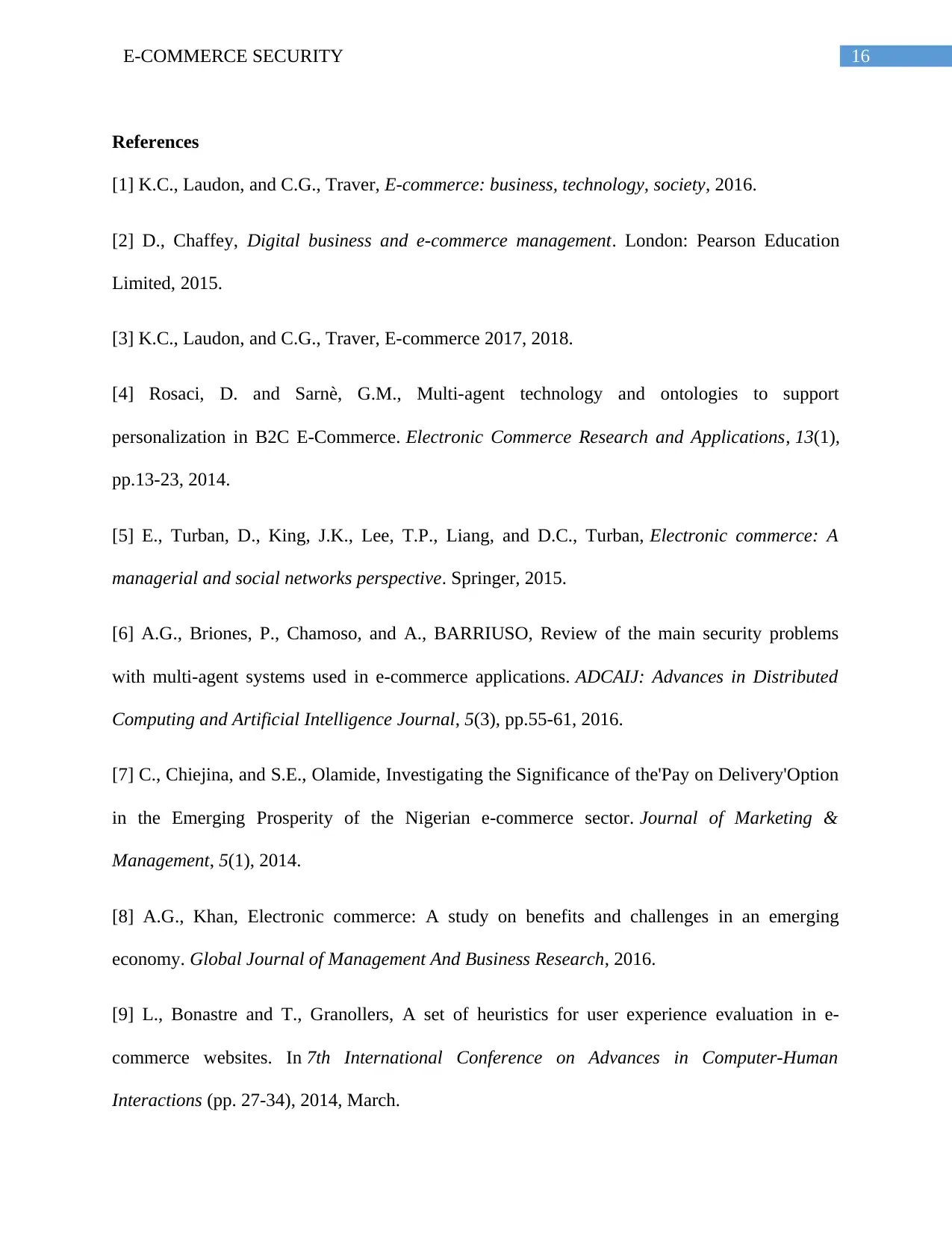
16E-COMMERCE SECURITY
References
[1] K.C., Laudon, and C.G., Traver, E-commerce: business, technology, society, 2016.
[2] D., Chaffey, Digital business and e-commerce management. London: Pearson Education
Limited, 2015.
[3] K.C., Laudon, and C.G., Traver, E-commerce 2017, 2018.
[4] Rosaci, D. and Sarnè, G.M., Multi-agent technology and ontologies to support
personalization in B2C E-Commerce. Electronic Commerce Research and Applications, 13(1),
pp.13-23, 2014.
[5] E., Turban, D., King, J.K., Lee, T.P., Liang, and D.C., Turban, Electronic commerce: A
managerial and social networks perspective. Springer, 2015.
[6] A.G., Briones, P., Chamoso, and A., BARRIUSO, Review of the main security problems
with multi-agent systems used in e-commerce applications. ADCAIJ: Advances in Distributed
Computing and Artificial Intelligence Journal, 5(3), pp.55-61, 2016.
[7] C., Chiejina, and S.E., Olamide, Investigating the Significance of the'Pay on Delivery'Option
in the Emerging Prosperity of the Nigerian e-commerce sector. Journal of Marketing &
Management, 5(1), 2014.
[8] A.G., Khan, Electronic commerce: A study on benefits and challenges in an emerging
economy. Global Journal of Management And Business Research, 2016.
[9] L., Bonastre and T., Granollers, A set of heuristics for user experience evaluation in e-
commerce websites. In 7th International Conference on Advances in Computer-Human
Interactions (pp. 27-34), 2014, March.
References
[1] K.C., Laudon, and C.G., Traver, E-commerce: business, technology, society, 2016.
[2] D., Chaffey, Digital business and e-commerce management. London: Pearson Education
Limited, 2015.
[3] K.C., Laudon, and C.G., Traver, E-commerce 2017, 2018.
[4] Rosaci, D. and Sarnè, G.M., Multi-agent technology and ontologies to support
personalization in B2C E-Commerce. Electronic Commerce Research and Applications, 13(1),
pp.13-23, 2014.
[5] E., Turban, D., King, J.K., Lee, T.P., Liang, and D.C., Turban, Electronic commerce: A
managerial and social networks perspective. Springer, 2015.
[6] A.G., Briones, P., Chamoso, and A., BARRIUSO, Review of the main security problems
with multi-agent systems used in e-commerce applications. ADCAIJ: Advances in Distributed
Computing and Artificial Intelligence Journal, 5(3), pp.55-61, 2016.
[7] C., Chiejina, and S.E., Olamide, Investigating the Significance of the'Pay on Delivery'Option
in the Emerging Prosperity of the Nigerian e-commerce sector. Journal of Marketing &
Management, 5(1), 2014.
[8] A.G., Khan, Electronic commerce: A study on benefits and challenges in an emerging
economy. Global Journal of Management And Business Research, 2016.
[9] L., Bonastre and T., Granollers, A set of heuristics for user experience evaluation in e-
commerce websites. In 7th International Conference on Advances in Computer-Human
Interactions (pp. 27-34), 2014, March.
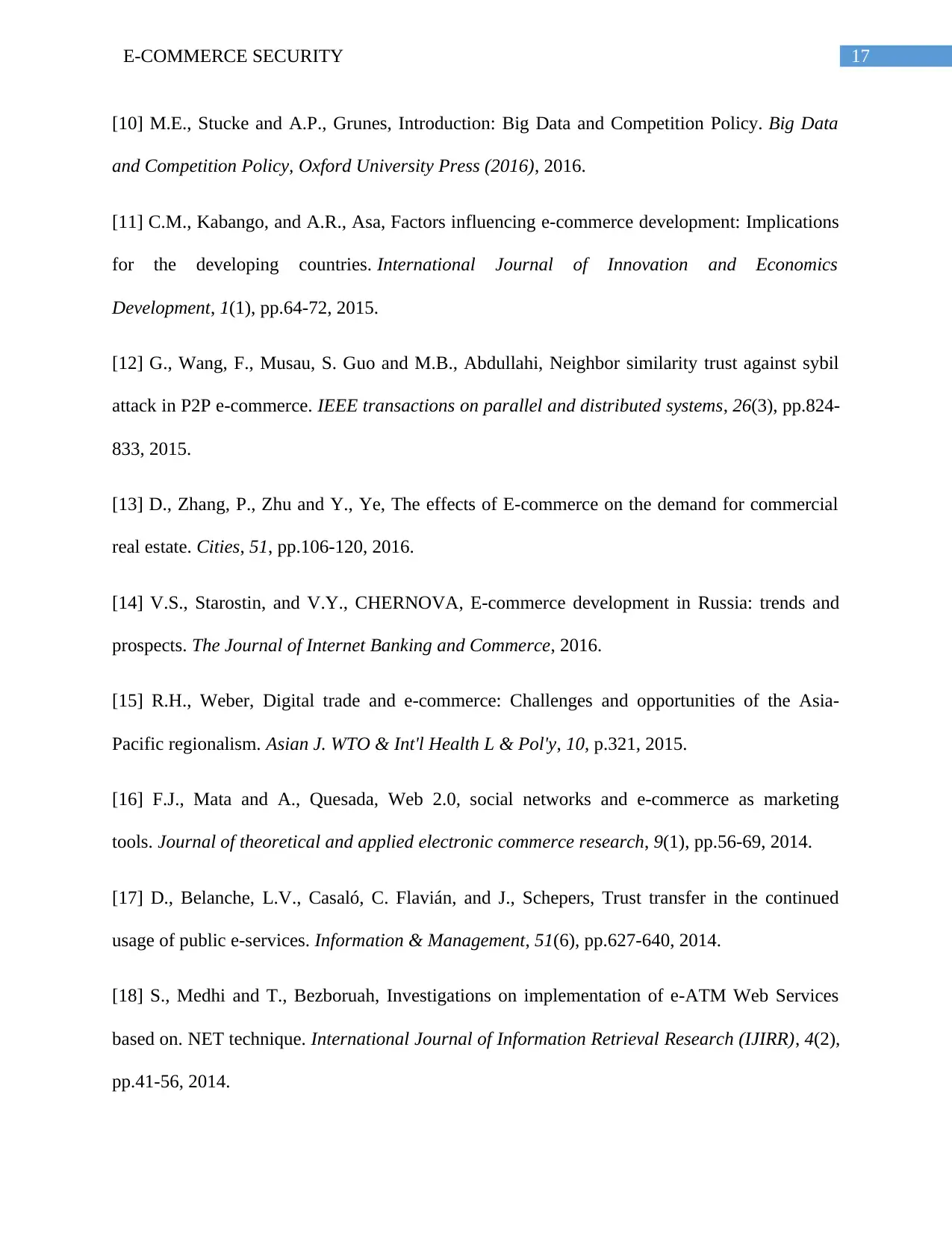
17E-COMMERCE SECURITY
[10] M.E., Stucke and A.P., Grunes, Introduction: Big Data and Competition Policy. Big Data
and Competition Policy, Oxford University Press (2016), 2016.
[11] C.M., Kabango, and A.R., Asa, Factors influencing e-commerce development: Implications
for the developing countries. International Journal of Innovation and Economics
Development, 1(1), pp.64-72, 2015.
[12] G., Wang, F., Musau, S. Guo and M.B., Abdullahi, Neighbor similarity trust against sybil
attack in P2P e-commerce. IEEE transactions on parallel and distributed systems, 26(3), pp.824-
833, 2015.
[13] D., Zhang, P., Zhu and Y., Ye, The effects of E-commerce on the demand for commercial
real estate. Cities, 51, pp.106-120, 2016.
[14] V.S., Starostin, and V.Y., CHERNOVA, E-commerce development in Russia: trends and
prospects. The Journal of Internet Banking and Commerce, 2016.
[15] R.H., Weber, Digital trade and e-commerce: Challenges and opportunities of the Asia-
Pacific regionalism. Asian J. WTO & Int'l Health L & Pol'y, 10, p.321, 2015.
[16] F.J., Mata and A., Quesada, Web 2.0, social networks and e-commerce as marketing
tools. Journal of theoretical and applied electronic commerce research, 9(1), pp.56-69, 2014.
[17] D., Belanche, L.V., Casaló, C. Flavián, and J., Schepers, Trust transfer in the continued
usage of public e-services. Information & Management, 51(6), pp.627-640, 2014.
[18] S., Medhi and T., Bezboruah, Investigations on implementation of e-ATM Web Services
based on. NET technique. International Journal of Information Retrieval Research (IJIRR), 4(2),
pp.41-56, 2014.
[10] M.E., Stucke and A.P., Grunes, Introduction: Big Data and Competition Policy. Big Data
and Competition Policy, Oxford University Press (2016), 2016.
[11] C.M., Kabango, and A.R., Asa, Factors influencing e-commerce development: Implications
for the developing countries. International Journal of Innovation and Economics
Development, 1(1), pp.64-72, 2015.
[12] G., Wang, F., Musau, S. Guo and M.B., Abdullahi, Neighbor similarity trust against sybil
attack in P2P e-commerce. IEEE transactions on parallel and distributed systems, 26(3), pp.824-
833, 2015.
[13] D., Zhang, P., Zhu and Y., Ye, The effects of E-commerce on the demand for commercial
real estate. Cities, 51, pp.106-120, 2016.
[14] V.S., Starostin, and V.Y., CHERNOVA, E-commerce development in Russia: trends and
prospects. The Journal of Internet Banking and Commerce, 2016.
[15] R.H., Weber, Digital trade and e-commerce: Challenges and opportunities of the Asia-
Pacific regionalism. Asian J. WTO & Int'l Health L & Pol'y, 10, p.321, 2015.
[16] F.J., Mata and A., Quesada, Web 2.0, social networks and e-commerce as marketing
tools. Journal of theoretical and applied electronic commerce research, 9(1), pp.56-69, 2014.
[17] D., Belanche, L.V., Casaló, C. Flavián, and J., Schepers, Trust transfer in the continued
usage of public e-services. Information & Management, 51(6), pp.627-640, 2014.
[18] S., Medhi and T., Bezboruah, Investigations on implementation of e-ATM Web Services
based on. NET technique. International Journal of Information Retrieval Research (IJIRR), 4(2),
pp.41-56, 2014.
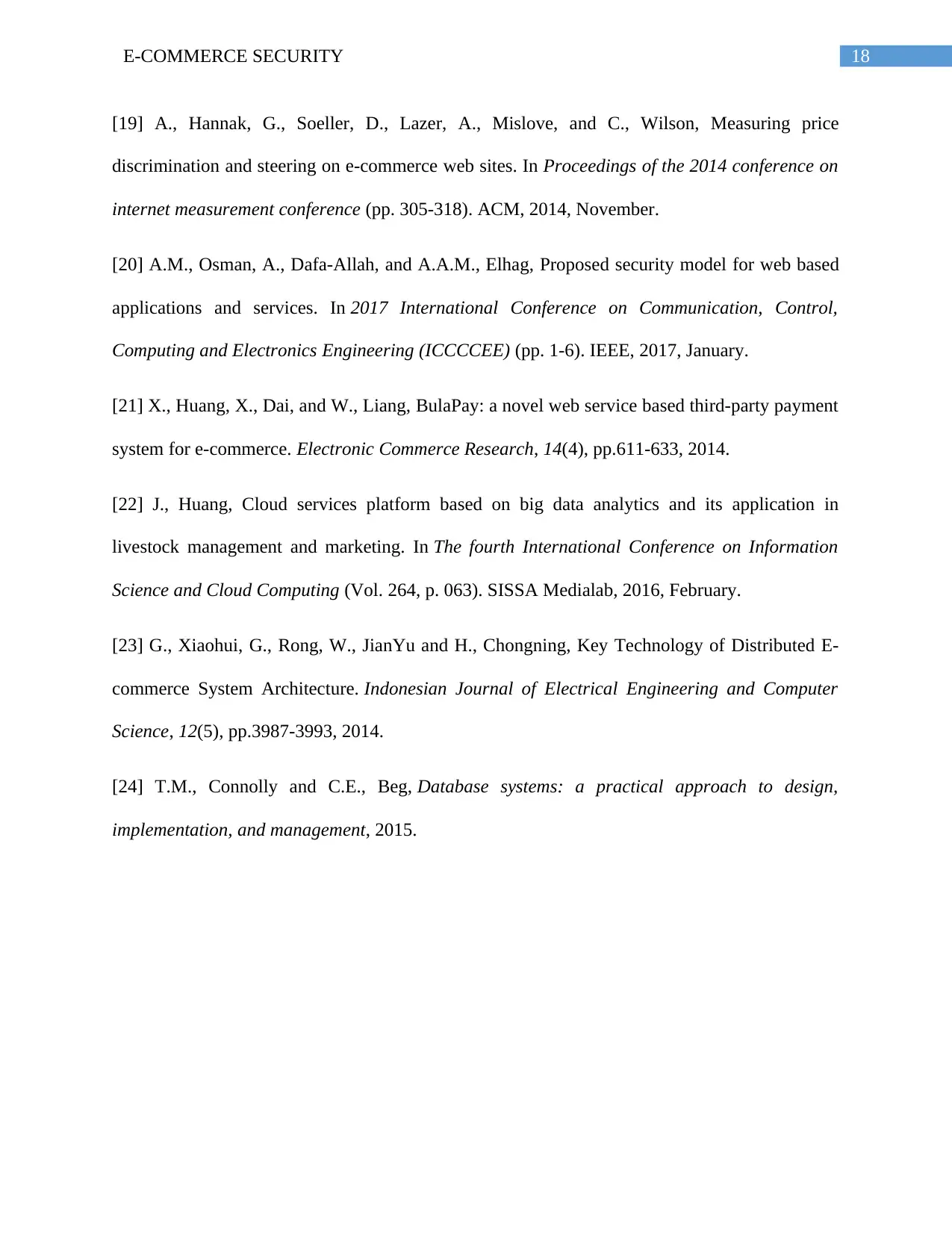
18E-COMMERCE SECURITY
[19] A., Hannak, G., Soeller, D., Lazer, A., Mislove, and C., Wilson, Measuring price
discrimination and steering on e-commerce web sites. In Proceedings of the 2014 conference on
internet measurement conference (pp. 305-318). ACM, 2014, November.
[20] A.M., Osman, A., Dafa-Allah, and A.A.M., Elhag, Proposed security model for web based
applications and services. In 2017 International Conference on Communication, Control,
Computing and Electronics Engineering (ICCCCEE) (pp. 1-6). IEEE, 2017, January.
[21] X., Huang, X., Dai, and W., Liang, BulaPay: a novel web service based third-party payment
system for e-commerce. Electronic Commerce Research, 14(4), pp.611-633, 2014.
[22] J., Huang, Cloud services platform based on big data analytics and its application in
livestock management and marketing. In The fourth International Conference on Information
Science and Cloud Computing (Vol. 264, p. 063). SISSA Medialab, 2016, February.
[23] G., Xiaohui, G., Rong, W., JianYu and H., Chongning, Key Technology of Distributed E-
commerce System Architecture. Indonesian Journal of Electrical Engineering and Computer
Science, 12(5), pp.3987-3993, 2014.
[24] T.M., Connolly and C.E., Beg, Database systems: a practical approach to design,
implementation, and management, 2015.
[19] A., Hannak, G., Soeller, D., Lazer, A., Mislove, and C., Wilson, Measuring price
discrimination and steering on e-commerce web sites. In Proceedings of the 2014 conference on
internet measurement conference (pp. 305-318). ACM, 2014, November.
[20] A.M., Osman, A., Dafa-Allah, and A.A.M., Elhag, Proposed security model for web based
applications and services. In 2017 International Conference on Communication, Control,
Computing and Electronics Engineering (ICCCCEE) (pp. 1-6). IEEE, 2017, January.
[21] X., Huang, X., Dai, and W., Liang, BulaPay: a novel web service based third-party payment
system for e-commerce. Electronic Commerce Research, 14(4), pp.611-633, 2014.
[22] J., Huang, Cloud services platform based on big data analytics and its application in
livestock management and marketing. In The fourth International Conference on Information
Science and Cloud Computing (Vol. 264, p. 063). SISSA Medialab, 2016, February.
[23] G., Xiaohui, G., Rong, W., JianYu and H., Chongning, Key Technology of Distributed E-
commerce System Architecture. Indonesian Journal of Electrical Engineering and Computer
Science, 12(5), pp.3987-3993, 2014.
[24] T.M., Connolly and C.E., Beg, Database systems: a practical approach to design,
implementation, and management, 2015.
1 out of 19
Related Documents
Your All-in-One AI-Powered Toolkit for Academic Success.
+13062052269
info@desklib.com
Available 24*7 on WhatsApp / Email
![[object Object]](/_next/static/media/star-bottom.7253800d.svg)
Unlock your academic potential
© 2024 | Zucol Services PVT LTD | All rights reserved.




